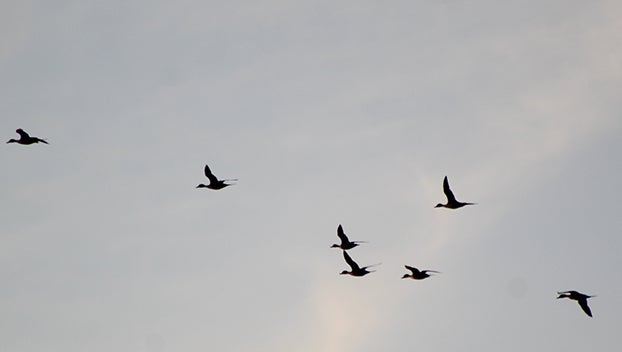2021-2022 Waterfowl report: Drought conditions improve, waterfowl population should rebound
Published 5:10 pm Thursday, October 27, 2022

- A flock of pintail ducks fly over The Swamp area of St. Catherine Creek National Wildlife Refuge at the Sibley Unit. (Hunter Cloud | The Natchez Democrat)
|
Getting your Trinity Audio player ready...
|
BATON ROUGE — The United States Fish and Wildlife Service published its 2021-2022 waterfowl population report on August 19. According to the report, breeding habitat in the northern US and Canada had deteriorated from 2019 to fall 2021 with ponds and other bodies of water in decline due to drought.
However, this spring there was a 10 percent increase in ponds in the breeding region for ducks.
The same report found a 12 percent decline in total duck population excluding long tailed ducks, scooters, eiders and wood ducks. USFWS reported a total of 32.4± 0.6 Million ducks in the population estimate. It was four percent lower than the long term average from 1955 to 2019.
Data was not collected for 2020 and 2021 due to the COVID-19 pandemic, USFWS Mississippi Flyway Representative Dave Scott said. Federal, Provincial and State agencies conduct the surveys used to generate the report.
While a decline in population numbers is a cause for concern from hunters, Scott said it was important to note a few things. First, they were unable to monitor those numbers the past years and 2022’s data was more in line with the long term average data.
The great plains had experienced drought until recently. North and South Dakotas, Saskatchewan, Alberta and Manitoba, where a majority of the ducks breed, have seen a recovery from drought this past year according to the North American Drought Map.
“It is a positive sign for the future. Total numbers might have been down but it is indicative of the weather conditions,” Scott said. “Drought conditions were more severe in North and South Dakota and Canada. When it is dry, there is less water and less places for them to breed. When you have better water conditions you will see an improvement. There has been a recovery and it is trending the right way. We are hoping they will take advantage of those breeding grounds.”
The Louisiana Department of Wildlife and Fisheries Waterfowl page states 36 percent of the banded birds killed in Louisiana were banded in Saskatchewan according to studies conducted from 1986 to 2012. 15 percent were banded in North Dakota, 12 percent in Manitoba, 10 percent in Alberta and 6 percent in South Dakota.
LDWF Waterfowl Program Director Jason Olszak said the numbers from the population survey and adaptive harvest models suggested they would be good for a liberal season framework next season. He and several other state wildlife agency representatives were at the Mississippi Flyway meeting last week.
“Our recommendation would be for another liberal framework. That is up to the taking for USFWS,” he said. “They will meet on that and we can select our seasons based on their frameworks.”
Hunter, harvest strategies
According to the Mississippi Flyways Council Flyway Data Book, estimates of 38,188 duck hunters took to were afield in Louisiana and 15,661 duck hunters were afield in Mississippi in 2020. Hunters in Louisiana took 19.7 ducks over the season and Mississippi hunters took 12.8 ducks both below the long term average of 22.1 ducks for Louisiana and 18.9 for Mississippi.
Of course the less ducks there are the less hunters will be able to take. Scott said the mid continent mallards, while down, were still at a population threshold where the USFWS could maintain the liberal package of 60 hunting days with a bag limit of six. He said it is unlikely to change anytime soon. Previous season limits have been 45 days and four ducks or 30 days and three ducks.
Bag limits and season dates are set by the USFWS based on the scientific data and recommendations from the Mississippi Flyway Council. Limits for different species of ducks are dependent on models of thresholds.
“Looking at the adaptive harvest models we are quite aways from moving to a restrictive framework,” Olszak said. “Numbers are down from the last time we had a count but looking at the long term average we are right at the average. Due to the wet spring up north there is potential for us to see higher production. I would expect to see a good fall flight.”
Mississippi Flyway Council held its meeting in Alabama last week to discuss the regulation recommendations for the 2023 season. One species of concern is the Northern Pintail, he said.
“The harvest management community is working on a harvest strategy for pintails long term,” he said. “We are using the numbers to figure out the optimal regulations package for 2023. We will meet tomorrow and make those recommendations to the USFWS and they will consider them.”
Blue-winged teal are doing really well number wise and it is likely their season will continue to be a 16 day hunting season in Sept. for the selective states such as Mississippi and Louisiana. Teal season opens Sept. 10 and closes Sept. 26 with a daily bag limit of six.
“A lot of duck populations were down but teal have increased based on the numbers. It was better news than what we expected,” he said. “We typically start seeing teal here in August. The peak is late September and October.”
Improving the duck habitat
Since 1965, LDWF sends 10 percent of fees collected from hunting license sales to developing and preserving breeding grounds. Mississippi Department of Wildlife, Fisheries, and Parks (MDWFP) takes a “diversified portfolio” approach in using stamp funds by first considering wetland and waterfowl needs within the state. Just in the past few years, state waterfowl stamp revenue has been used for the improvement of habitat and public hunting land.
Hunters are involved in the habitat improvement process by purchasing the required licenses and duck stamps. They can become more involved by submitting public comments and engaging with the flyway council and state agencies.
Olszak recommends people read literature on managing different types of waterfowl habitat on the LDWF website or USFWS website. There are a few things habitat managers, duck hunters and landowners can do to help ducks in Louisiana.
“One of our big limiting factors last year was water. It was pretty darn dry,” he said. “One of the things people can do is make a commitment to holding water throughout the year for waterfowl. They can also plant food for wintering waterfowl who survive the hunting season.”
Scott added one more way hunters could help ducks in the future.
“I encourage them to take a kid hunting and introduce someone else to waterfowl hunting. It might become something they love,” he said. “Do what you can to improve habitat where you are and to improve it where it matters most. You can make an impact by introducing new people to the sport.”
Mississippi duck stamp projects
Waterfowl Program Coordinator Houston Havens took to the podium last week at the October MDWFP Commission Meeting to present a series of duck stamp projects. Money collected through the state waterfowl duck stamp helps fund projects every year.
His proposal was to allocate $659,570 in funding to projects for the 2022-2023 season. MDWFP’s commission voted to approve the projects and amount of funding they will receive to make it final.
Breeding habitat programs through Ducks Unlimited and DU Canada and Delta Waterfowl are two projects the state duck stamp funds. Ducks Unlimited and DU Canada will receive $125,000 to continue funding work on improving breeding habitat in Saskatchewan. Delta Waterfowl will receive $125,000 to improve breeding habitat in Manitoba through Adopt a Pothole. Havens said the majority of ducks seen and harvested in the Mississippi Flyway come from those Canadian provinces.
“We are a proud state who contributes our funds to birds that will end up on our wintering grounds,” Havens said. “They match our funds with other state agencies and other programs to increase the impact of those dollars.”
Mississippi State University will receive $38,771 for research on Wood Duck nesting boxes and the impact they have on wood duck populations. MSU’s project is collaborative with several other state agencies in the Southeast region. Other items to receive funding include:
- WMAs to address management needs – $250,000
- WMAs receiving the aid are Malmaison, Charlie Capps, Mahannah, Sky Lake and other WMAs as needed.
- Private lands wetland infrastructure program- $40,000
- Aerial Waterfowl Surveys- $31,000
- Waterfowl program training and travel- $9,000
- Waterfowl trapping and banding equipment- $5,000
- Mississippi Flyway Council dues, banding and cooperative projects- $28,799
- MDWFP’s Youth Waterfowl Camp- $7,000
This year, the MDWFP banded 400 wood ducks and 600 mourning doves. Throughout the hunting season, they will receive reports of harvested banded birds.
“A couple of weeks ago we received one from a wood duck we banded here in 2018 that was harvested in Ontario, Canada,” Havens said.
| Species | Population 2022 | Population 2019 | Percent Change 2022 to 2019 | Average Long term Population (1955-2019) | Percent Change |
| Mallards | 7.2 ± 0.2 Million | 9.4 ± 0.3 Million | 24% lower | 7.4 ± 0.04 Million | 9% lower |
| Blue-Winged Teal | 6.5 ± 0.3 Million | 5.2 ± 0.06 Million | 19% higher | 5.1 ± 0.04 Million | 27% higher |
| Gadwalls | 2.7 ± 0.1 Million | 3.2 ± 0.04 Million | 18% lower | 2.0 ± 0.2 Million | 30% higher |
| Northern Shoveler | 3.0 ± 0.2 Million | 3.6 ± 0.2 Million | 17% lower | 2.6 ± 0.02 Million | 15% higher |
| Green-Winged Teal | 2.2 ± 0.02 Million | 3.2 ± 0.2 Million | 32% lower | 2.2 ± 0.02 Million | N/A |
| Canvasbacks | 0.6 ± 0.05 Million | 0.6 ± 0.05 Million | N/A | 0.6 ± 0.05 Million | N/A |
| Redheads | 1.0 ± 0.1 Million | 0.7 ± 0.02 Million | 35% higher | 0.7 ± 0.01 Million | 36% higher |
| Northern Pintail | 1.8 ± 0.2 Million | 2.3 ± 0.1 Million | 21% lower | 3.9 ± 0.03 Million | 54% lower |
| Wigeon | 2.1 ± 0.1 Million | 2.6 ± .25 Million | 25% lower | 2.6 ± 0.02 Million | 19% lower |
| Greater and Lesser Scaup | 3.6 ± 0.2 Million | 3.6 ± 0.2 Million | N/A | 5.0 ± 0.04 Million | 28% lower |






